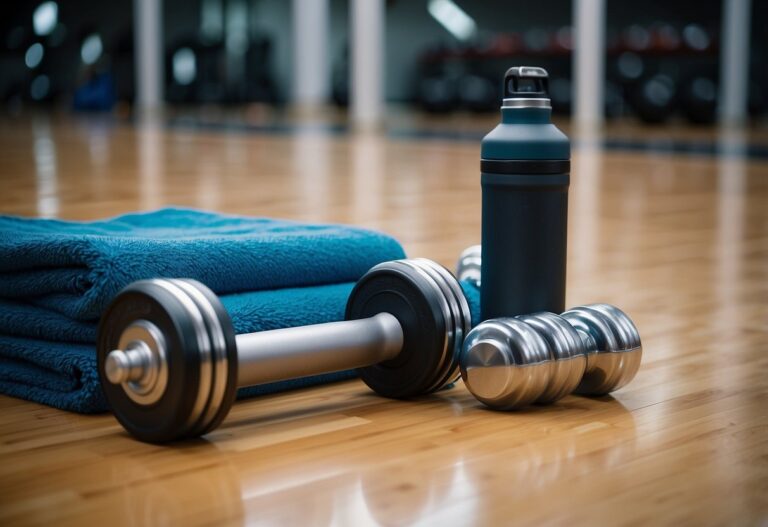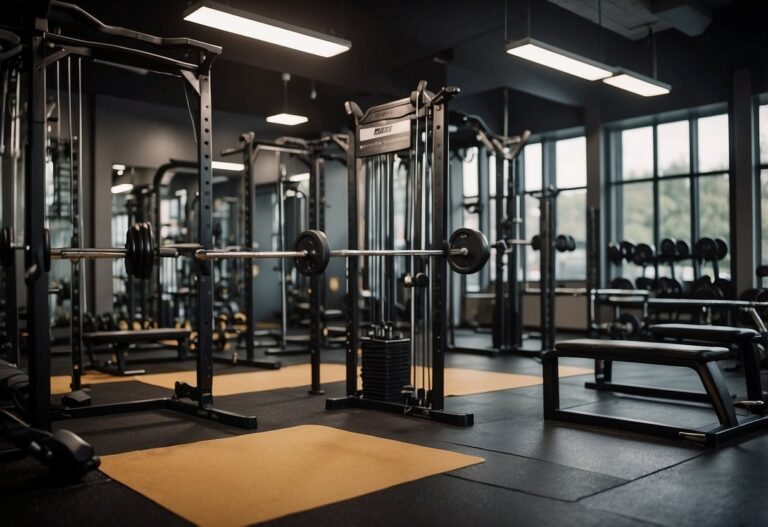When looking to cut weight and achieve a lean physique, knowing where to start can be overwhelming. It’s important to combine the right workout routines with proper dietary habits to see the best results. Understanding the basics of cutting workouts can transform your fitness journey, helping you maintain lean muscle while shedding fat.

Adopting a structured approach to cutting workouts can make all the difference. You’ll need to balance your training with nutrition in a way that suits your goals and lifestyle. Stay committed and you’ll find that getting lean is not just achievable but also sustainable.
Incorporate HIIT Workouts
Adding HIIT workouts to your routine is a great way to boost fat loss. These workouts mix short bursts of high-intensity exercise with periods of rest or lower-intensity exercise.
A popular method is Tabata, which includes 20 seconds of intense exercise followed by 10 seconds of rest. You can try different activities, like sprints, jumps, or burpees.
Another option is the 30-20-10 routine. This involves 30 seconds of low intensity, 20 seconds of moderate intensity, and 10 seconds of high intensity. Rotate through different exercises to keep things fresh.
Remember to listen to your body and take rest days to prevent injury.
Focus on Compound Exercises

When you’re in a cutting phase, focusing on compound exercises is crucial. These involve multiple joints and muscle groups, helping you burn more calories. Think about incorporating squats, deadlifts, and bench presses into your routine.
Compound exercises like these can also help you maintain muscle mass. This is important because you want to lose fat, not muscle. By working multiple muscle groups, you’re making your workouts more efficient.
Keep your rest periods shorter, around 30-45 seconds. This will keep your heart rate up and maximise fat burning. You can read more about the importance of rest periods during cuts here.
Include plenty of protein pre and post-workout
Eating protein before and after your workout can help build and repair muscles. Before you exercise, consider eating egg whites with whole grain bread. It’s an easy meal with quick-digesting protein and moderate carbs.
After your workout, try a meal with both protein and carbs. For example, a smoothie made with milk, protein powder, and banana can be a great choice. This helps replenish your energy and supports muscle recovery.
Greek yogurt with fruit is another good option post-workout. It’s quick, easy, and packed with protein to help reduce muscle soreness.
Maintain Consistent Hydration

Staying hydrated is essential for effective workouts. Drink water throughout the day and not just before or after exercising. Aim for half your body weight in ounces on rest days. When you’re active, drink 16 to 24 ounces of water two hours before your workout The Best Way to Hydrate.
During exercise, consume 150-350 millilitres of fluid every 15-20 minutes to maintain hydration Optimal Fluid Intake Guidelines. Listen to your body and adjust based on intensity, duration, and sweat rate. This helps prevent dehydration and supports muscle function.
Remember, proper hydration can enhance your energy levels, improve performance, and aid muscle recovery. Make it a habit to carry a water bottle with you and take regular sips.
Increase Your Repetitions Gradually
When cutting, increasing your repetitions gradually is important for preventing injuries and boosting endurance. Start with a weight you can handle with good form. Once you feel comfortable, you can begin to add reps linearly.
Imagine you start at three sets of eight reps; next time, aim for three sets of nine. This slow and steady increase helps your muscles adapt and grow stronger without overloading them suddenly.
It’s tempting to rush, but control is key. Focusing on form ensures you’re building muscle efficiently and safely. Always listen to your body and make adjustments as needed.
Avoid Long Rest Periods Between Sets
Keeping your rest periods short can boost your workout intensity. When you limit rest to around 1-2 minutes, it keeps your heart rate up and helps burn more calories. This is especially useful when you’re aiming to cut fat.
If you’re aiming to build muscle, shorter rest times can also be effective. For instance, resting for about 1.5 minutes between sets maximises gains. This approach allows your muscles to stay engaged without fully recovering, which can promote growth.
Remember, not all exercises require the same rest duration. Isolation exercises like bicep curls might need shorter breaks, while compound movements like squats can demand a bit more rest. Tailor your rest periods to match the intensity of your workout for the best results.
Try experimenting with different rest intervals to see what works best for your body and fitness goals. Stay consistent, and you’ll likely notice improvements in both your endurance and muscle definition. Keep pushing your limits, but always listen to your body to prevent overtraining.
Utilise Bodyweight Exercises
Bodyweight exercises are a great way to get in shape without needing any special equipment. They can be done anywhere, whether you’re at home, in a park, or travelling.
Push-ups are a staple in bodyweight workouts. They target your chest, shoulders, and triceps. Start with a few reps and gradually increase as you get stronger.
Squats use your body weight to build strength in your legs and glutes. They’re simple to perform but very effective. Aim for three sets of 10-15 reps.
Pull-ups work your back and biceps. If you can’t do a full pull-up yet, try assisted variations until you build up enough strength.
Incorporating different bodyweight exercises keeps your routine varied and exciting. This can help maintain your motivation and ensure you are working multiple muscle groups.
For more detailed routines and examples, check out this guide on bodyweight exercises.
Balance Cardio and Strength Training
Combining cardio and strength training can help you reach your fitness goals more efficiently. Start by alternating between these workouts. For instance, use high-intensity interval training (HIIT) where you do strength exercises followed by cardio. This method boosts both endurance and muscle growth.
Balance is key. Aim for at least two strength training sessions per week, targeting all major muscle groups. Coupling this with moderate cardio three times a week keeps your heart healthy. Adjust your routine based on how you feel and your progress.
Introduce Resistance Bands into Routines
Using resistance bands in your workout can make a significant difference. They’re compact and versatile, making it easy to train at home or while travelling. Resistance bands are suitable for all fitness levels.
Adding exercises like banded deadlifts, squats, and rows can enhance your routine. These moves target various muscle groups effectively. For instance, bent over rows with bands will work your back and shoulders without needing heavy weights.
Think about incorporating resistance bands for stretching too. They help in getting deeper into stretches. For example, upper back stretches with bands can relieve tension and improve flexibility. Simply loop the band around your foot and pull gently to feel the stretch.
Don’t forget about plyometric exercises. Bands can add resistance to jumps and other explosive moves, burning more calories and improving power. Using bands in this way can keep your workouts fun and varied.
Give it a try! Replace one traditional strength training day with a band workout and feel the difference. Feel more engaged and challenge muscles differently.
Monitor Your Caloric Intake
When you’re cutting, it’s crucial to monitor your caloric intake carefully. Start by determining your Total Daily Energy Expenditure (TDEE), then reduce it by 10-20% to create a caloric deficit. This helps in burning fat while preserving muscle.
Track your macronutrients. Aim to get around 40% of your calories from protein, 20-30% from fats, and the rest from carbohydrates. This balance helps in maintaining muscle mass while losing fat.
Using apps to track your calories can be super helpful. They make it easy to log your meals and monitor your progress.
Understanding Cutting and Workouts
Cutting involves losing fat while maintaining muscle. Effective strategies include the right mix of diet and exercise. This combination ensures you do not lose muscle mass, which is critical for your overall fitness.
The Science Behind Cutting
Cutting requires a calorie deficit. This means you consume fewer calories than your body uses. This forces your body to use stored fat for energy. Weightlifting is essential as it helps preserve muscle mass. When mixed with cardio, it can enhance your fat loss.
Metabolism plays a big role in cutting. As you cut calories, your metabolism may slow down. To counter this, you should include high-protein foods in your diet. Protein helps to maintain metabolism and muscle mass. It also keeps you feeling fuller for longer.
Hormones also impact cutting. Insulin, for instance, can affect how your body stores and uses fat. Balancing your carbs and sugars can help manage insulin levels. This aids in fat loss without causing energy dips.
Balancing Diet and Exercise
To successfully cut, balance your diet and workouts. High-protein diets are a must. They help keep your muscle while you lose fat. Include lean meats, fish, eggs, and plant-based proteins in your meals.
Carbohydrates should not be zero but managed well. Focus on complex carbs like whole grains and vegetables. They provide energy and help you stay active during workouts.
When it comes to exercise, circuit training is a great choice. It combines strength and cardio. This keeps your heart rate up, burning more calories. Another option is Hypertrophy Specific Training (HST). It focuses on muscle maintenance with short rest periods to keep the intensity high.
Including cardio exercises such as running or cycling can boost your results. Aim for low-intensity long-duration cardio sessions to support heart and respiratory health. Balancing these activities with strength training ensures a comprehensive approach to cutting.
Effective Cutting Workout Strategies

Cutting phase workouts should focus on burning fat while maintaining muscle. Key strategies include high-intensity interval training (HIIT) and strength training to maximise fat loss.
High-Intensity Interval Training (HIIT)
HIIT involves short, intense bursts of exercise followed by brief rest periods. This method is effective for burning calories and improving cardiovascular fitness. You can perform HIIT with various exercises like sprints, cycling, or bodyweight movements.
The key to effective HIIT is intensity. You should push yourself to your maximum effort during the high-intensity intervals. For example, sprint for 30 seconds, followed by 30 seconds of walking. Repeat this for 20-30 minutes.
HIIT sessions are typically shorter than traditional cardio workouts but can burn more calories. They also help in preserving muscle mass, which is crucial during a cutting phase.
Strength Training for Fat Loss
Strength training helps you maintain muscle mass while you’re losing fat. It’s important to lift weights and perform compound exercises like squats, deadlifts, and bench presses. These exercises engage multiple muscle groups, increasing calorie burn.
When cutting, aim for a rep range of 4-10 reps per set with moderate to heavy weights. This range stimulates muscle growth and strength. Ensure you have proper form to avoid injuries.
Incorporate rest periods of one to two minutes between sets. This helps you recover slightly without losing the intensity needed for fat loss. Strength training can be done 3-4 times a week, allowing your muscles to recover and grow.







